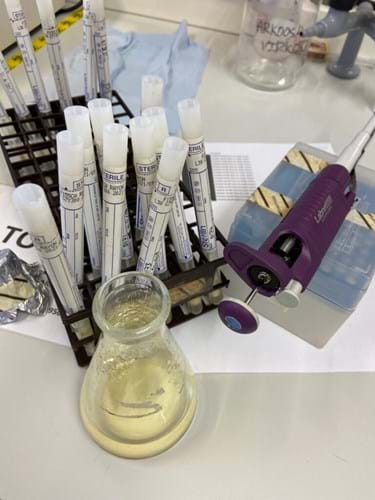Pause carousel
Play carousel

RESEARCH BLOG: Lauren Arkoosh is in the second year of her PhD at Abertay University and studies seals as a sentinel species of antimicrobial resistance. She originally wrote this blog post for The Mammal Society, who featured her as their Student of the Month.
Antimicrobial resistance genes (AMRG), and their spread, are a growing threat to human health (Vittecoq et al., 2016). Resistant infections account for 700,000 deaths each year and this number is estimated to increase to 10 million by 2050 (O’Neill, 2016). AMRG are considered by some to be a more immediate threat to the human race than climate change (Anjum, 2015). For example, resistance to colistin, a “last resort” antibiotic, has become a pressing issue (Schwarz and Johnson, 2016). Recently, a study determined that only 3% of research on AMRG relates to the environment (Kelly et al., 2016). The scientific community clearly needs to determine AMRG hotspots, and monitor them before the threat can grow (Crofts et al., 2017).
Aquaculture, agriculture, and human and animal waste drive the spread of AMRGs through the environment (Singer et al., 2016). Understanding the role of wild animals as vectors and reservoirs of AMRGs is a major knowledge gap in addressing global AMRG transmission.
Seals are top predators in UK waters. They regularly return to haul out on shore, providing a simple way for us to sample their faeces to detect AMRGs present in their gut from the food they have eaten. Horizontal gene transfer between bacteria in the seal gut allows AMRGs to move between harmless and disease-causing bacteria, so the presence of genes in gut bacteria may be used as an early warning of their transfer to pathogens. Previous studies on marine mammals have examined a small number of known pathogens for AMRGs, resulting in limited understanding of AMRG prevalence in both harmless and disease-causing bacteria in the environment. Sampling pinnipeds faecal matter for AMRG allows us to search for genes present in the marine and coastal environment that would otherwise be extremely difficult, time consuming, and costly to find.

ABOVE: My first delivery of Seal Poo in a biohazard briefcase. (C) Laura Oller Lopez
I use traditional PCR (Polymerase Chain Reaction) and gel electrophoresis methods to determine presence or absence of selected AMRG in the seal gut as a proxy for their presence in the food chain. Tracking data and samples have been collected from approximately 120 animals in West Scotland, North Scotland, Orkney, the Outer Hebrides, the Moray Firth, and Wales. Once presence/absence is determined across regions and coupled with seal tracking data, I will create a map showing where different AMRG occur and how seals may spread AMRG in UK waters.
My preliminary screens have showed positive results to all classes of antibiotics tested with the exception of the polymyxins. About 30% of all samples tested exhibited the presence of resistance to tetracycline, which is commonly used as a prophylactic antibiotic in aquaculture. The screen used in this project will work on a 96 well plate, allowing me to simultaneously test for the presence of over 90 genes at once for each sample. I expect the data set to grow over the next few months to provide a clearer picture of the seal gut resistome in UK waters.

ABOVE: Faecal swabs ready for DNA extraction. (C) Lauren Arkoosh

ABOVE: Primers organised and ready to go! (C) Lauren Arkoosh
I am nearing the end of the second year of my PhD, which has been spent developing and testing the screen and sampling methods, as well as extracting DNA from samples collected in preparation for screening. In my remaining time, I will run extracted DNA through the screen I have designed and then compare positives and negatives in different areas around the UK, as well as make a predictive map of the presence of AMRG in UK waters. It is my intention that my final product will inform other scientists, governmental agencies, and the public about antimicrobial resistance in our waters to help us better understand the environmental component of the threat from antimicrobial resistance.
First and foremost, I would like to thank my supervisors, Dr. Scott Cameron and Dr. Kimberley Bennett from Abertay University, and Dr. Debbie Russell from The University of St Andrews. I would like to thank Abertay RLINCS studentships for my funding, as well as all of the SMRU staff involved in collecting the samples for me to test and for providing the mapping data for analysis. I would also like to thank my labmate Laura Oller Lopez, as well as my parents, Grandma Betty, my siblings, and my partner James for their support.
Please feel free to contact me with questions or comments at 1805576@uad.ac.uk
Anjum, M. F. (2015) ‘Screening methods for the detection of antimicrobial resistance genes present in bacterial isolates and the microbiota’, Future microbiology, 10(3), pp. 317-320.
Crofts, T. S., Gasparrini, A. J. and Dantas, G. (2017) ‘Next-generation approaches to understand and combat the antibiotic resistome’, Nature Reviews Microbiology, 15(7), pp. 422.
Kelly, R., Zoubiane, G., Walsh, D., Ward, R. and Goossens, H. (2016) ‘Public funding for research on antibacterial resistance in the JPIAMR countries, the European Commission, and related European Union agencies: a systematic observational analysis’, The Lancet Infectious Diseases, 16(4), pp. 431-440.
O’Neill, J. (2016) ‘Tackling drug-resistant infections globally: Final report and recommendations. 2016’, HM Government and Welcome Trust: UK.
Schwarz, S. and Johnson, A. P. (2016) ‘Transferable resistance to colistin: a new but old threat’, Journal of Antimicrobial Chemotherapy, 71(8), pp. 2066-2070.
Singer, A. C., Shaw, H., Rhodes, V. and Hart, A. (2016) ‘Review of antimicrobial resistance in the environment and its relevance to environmental regulators’, Frontiers in microbiology, 7, pp. 1728.
Vittecoq, M., Godreuil, S., Prugnolle, F., Durand, P., Brazier, L., Renaud, N., Arnal, A., Aberkane, S., Jean‐Pierre, H., Gauthier‐Clerc, M., Thomas, F. d. r. and Renaud, F. (2016) ‘Antimicrobial resistance in wildlife’, Journal of applied ecology, 53(2), pp. 519-529.